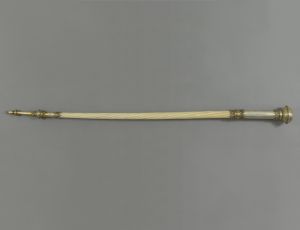
The Gothic edifice of Collegium Maius, the oldest building of the Jagiellonian University, used to house the Faculty of Law and Faculty of Liberal Arts. The rooms inside Collegium Maius served various roles. Two small rooms in the first floor were used as the treasury where the most valuable documents, books, and valuables were kept safe.
When Professor Karol Estreicher junior was designing the Jagiellonian University Museum’s exhibition inside the Collegium Maius building after its post-WW2 restoration, he put the new Treasury exhibition into the two rooms of the historical treasury. In a strongbox acquired from the interwar Alfred Honzer Bank he placed the university insignia, the rector’s ring and four sceptres, symbolizing the authority of the rector. Only one of the four sceptres on display has always been used as an official rector’s sceptre. The object was funded by King Ladislaus the Jagiellonian and made in one of Cracow goldsmith’s workshops ca. 1403–1405. The statutes of the university after King Ladislaus reestablished it in 1400 determined the rector’s administrative and judicial authority over all faculties. The prestigious rank of rector’s office was emphasised by his attire and insignia of power, as well as by the assistance of two beadles, the servants executing the will of rector’s court. The care for the splendour of the rector's office at the time was evidenced by the words of Dean Franciszek of Brzeg in the first part of the lecture Date et dobitur vobis, delivered to students in 1409. The scholar spoke of the duty of reverence and obedience to the rector ''who represents God for us in everything that is clearly not against God'' (quote from: Z. Kozłowska, Z. Kozłowska-Budkowa, "Odnowienie jagiellońskie Uniwersytetu Krakowskiego (1390-1414)", in: Z. Kozłowska-Budkowa, Studia z dziejów kultury średniowiecznego Krakowa, ed. St. Szczur, Kraków, 2015, pp. 256–258).
The other three sceptres originally served as symbols of the cardinal’s authority, the most prominent ecclesiastical dignitary after the pope. They were bequeathed to the university by the last wills of their owners. The oldest of them is the sceptre of Cardinal Zbigniew Oleśnicki (died in 1455), made around 1449 in a Cracow goldsmith's workshop. Another sceptre belonged to Cardinal Frederick Jagiellon (d. 1503) and was made by Cracow goldsmith Marcin Marciniec ca. 1495. The third sceptre of Cardinal Bernard Maciejowski (d. 1608) was made by an unknown Cracow goldsmith ca. 1603 from a narwhal tusk with gilded silver fittings on both sides.
All three cardinals were bishops of Cracow and, for this reason, chancellors of the university. The three cardinal sceptres preserved in the university collection are probably the oldest surviving cardinal sceptres in the world. The origins of the sceptre made of narwhal tusk are particularly mysterious due to unique material it was made of, which was very expensive at the time. Its history will be presented in subsequent texts as part of the Quarterly Exhibit series.

